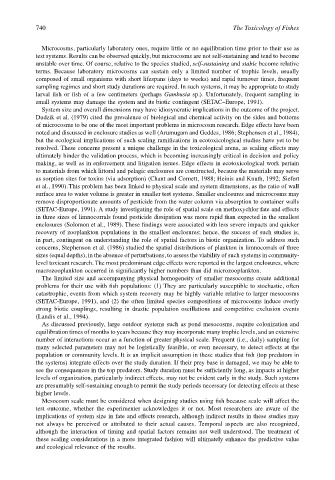Page 760 - The Toxicology of Fishes
P. 760
740 The Toxicology of Fishes
Microcosms, particularly laboratory ones, require little or no equilibration time prior to their use as
test systems. Results can be observed quickly, but microcosms are not self-sustaining and tend to become
unstable over time. Of course, relative to the species studied, self-sustaining and stable become relative
terms. Because laboratory microcosms can sustain only a limited number of trophic levels, usually
composed of small organisms with short lifespans (days to weeks) and rapid turnover times, frequent
sampling regimes and short study durations are required. In such systems, it may be appropriate to study
larval fish or fish of a few centimeters (perhaps Gambusia sp.). Unfortunately, frequent sampling in
small systems may damage the system and its biotic contingent (SETAC–Europe, 1991).
System size and overall dimensions may have idiosyncratic implications in the outcome of the project.
Dudzik et al. (1979) cited the prevalence of biological and chemical activity on the sides and bottoms
of microcosms to be one of the most important problems in microcosm research. Edge effects have been
noted and discussed in enclosure studies as well (Arumugam and Geddes, 1986; Stephensen et al., 1984),
but the ecological implications of such scaling ramifications in ecotoxicological studies have yet to be
resolved. These concerns present a unique challenge in the toxicological arena, as scaling effects may
ultimately hinder the validation process, which is becoming increasingly critical in decision and policy
making, as well as in enforcement and litigation issues. Edge effects in ecotoxicological work pertain
to materials from which littoral and pelagic enclosures are constructed, because the materials may serve
as sorption sites for toxins (via adsorption) (Chant and Cornett, 1988; Heinis and Knuth, 1992; Siefert
et al., 1990).This problem has been linked to physical scale and system dimensions, as the ratio of wall
surface area to water volume is greater in smaller test systems. Smaller enclosures and microcosms may
remove disproportionate amounts of pesticide from the water column via absorption to container walls
(SETAC-Europe, 1991). A study investigating the role of spatial scale on methoxychlor fate and effects
in three sizes of limnocorrals found pesticide dissipation was more rapid than expected in the smallest
enclosures (Solomon et al., 1989). These findings were associated with less severe impacts and quicker
recovery of zooplankton populations in the smallest enclosures; hence, the success of such studies is,
in part, contingent on understanding the role of spatial factors in biotic organization. To address such
concerns, Stephenson et al. (1986) studied the spatial distributions of plankton in limnocorrals of three
sizes (equal depths), in the absence of perturbations, to assess the viability of such systems in community-
level toxicant research. The most predominant edge effects were reported in the largest enclosures, where
macrozooplankton occurred in significantly higher numbers than did microzooplankton.
The limited size and accompanying physical homogeneity of smaller mesocosms create additional
problems for their use with fish populations: (1) They are particularly susceptible to stochastic, often
catastrophic, events from which system recovery may be highly variable relative to larger mesocosms
(SETAC-Europe, 1991), and (2) the often limited species compositions of microcosms induce overly
strong biotic couplings, resulting in drastic population oscillations and competitive exclusion events
(Landis et al., 1994).
As discussed previously, large outdoor systems such as pond mesocosms, require colonization and
equilibration times of months to years because they may incorporate many trophic levels, and an extensive
number of interactions occur as a function of greater physical scale. Frequent (i.e., daily) sampling for
many selected parameters may not be logistically feasible, or even necessary, to detect effects at the
population or community levels. It is an implicit assumption in these studies that fish (top predators in
the systems) integrate effects over the study duration. If their prey base is damaged, we may be able to
see the consequences in the top predators. Study duration must be sufficiently long, as impacts at higher
levels of organization, particularly indirect effects, may not be evident early in the study. Such systems
are presumably self-sustaining enough to permit the study periods necessary for detecting effects at these
higher levels.
Mesocosm scale must be considered when designing studies using fish because scale will affect the
test outcome, whether the experimenter acknowledges it or not. Most researchers are aware of the
implications of system size in fate and effects research, although indirect results in these studies may
not always be perceived or attributed to their actual causes. Temporal aspects are also recognized,
although the interaction of timing and spatial factors remains not well understood. The treatment of
these scaling considerations in a more integrated fashion will ultimately enhance the predictive value
and ecological relevance of the results.

